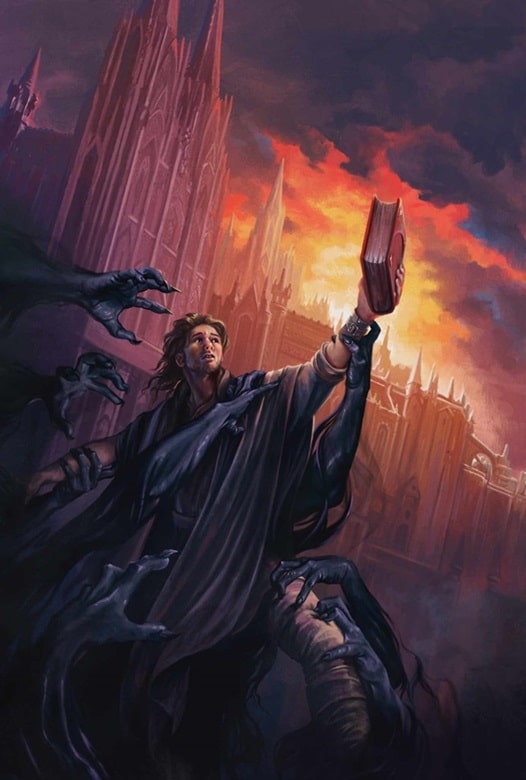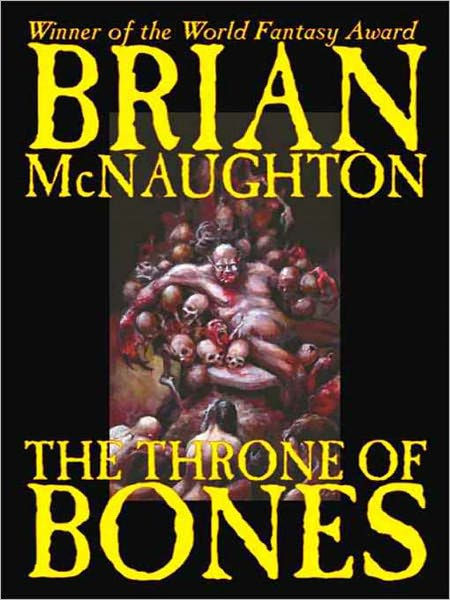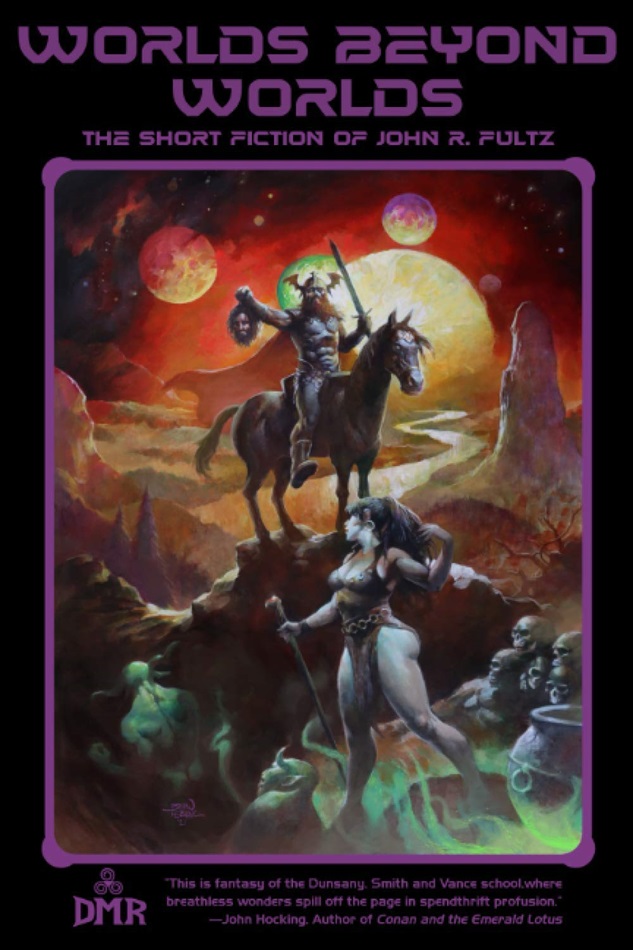The Revelations of Zang by John R. Fultz released by Rogues in the House: Read the Foreword and Interview
The Revelations of Zang by John R. Fultz. The Rogues
in the House Podcast (2023). John Molinero cover art.
The Rogues in the House Podcast, publishers of the Sword & Sorcery anthologies A Book of Blades Vol I and Vol II, now bring us a re-release of John R. Fultz’s The Revelations of Zang (available now in Kindle, Paperback, and Hardcover).
John R. Fultz is no stranger to Black Gate having published in the hardcopy magazine and hosting his Skulls graphic story plus two of his short stories on our website. We recently highlighted a 2017 interview with the author on his approach to creating weird worlds that are both beautiful and dark (reposted on Black Gate Dec. 2023). I was honored to provide the Foreword and Interview for the re-release, and share those here to reveal what you should expect, and why you should read, The Revelations of Zang!
John R. Fultz has a burgeoning library. His published novels include Seven Princes (2012), Seven Kings (2013), and Seven Sorcerers (2013), as well as The Testament of Tall Eagle (2015) and Son of Tall Eagle (2017). His short stories have appeared in Year’s Best Weird Fiction, Weird Tales, Black Gate, Weirdbook, That Is Not Dead, Shattered Shields, Lightspeed, Way of the Wizard, Cthulhu’s Reign, and plenty of other strange places. His story collections include World Beyond Worlds (2021), Darker Than Weird (2023), and The Revelations of Zang (re-released now, 2023)! Now, we will reveal to you the secret arcana of that last volume…
“The Magical Power of Art” – Foreword and Interview for The Revelations of Zang
The uninitiated may ask: who the hell is Zang? What is s/he going to reveal to me? Well, Zang is not human. It is the larger portion of the ‘Continent,’ a forest mostly; but the land is so rich in character, it might as well be sentient. This foreword reveals what to expect in The Revelations of Zang collection, avoiding spoilers, and it showcases the behind-the-scenes context of the stories and the author’s rich history with creating illustrated and fantastical worlds.
If Karl Edward Wagner rewrote The Worm Ourborus (E.R. Edison, 1922) for fans of The Dark Crystal (Jim Henson, Frank Oz, 1982) you’d get the Zang Cycle experience. It is tough to blend action-packed adventure with weird milieus, with doses of royal intrigue and epic, elder lore. Wagner delivered this well with his Kane character; i.e., in Darkness Weaves (1978), and “Lynortis Reprise (1961). Fultz excels at this too. The Revelations of Zang is an epic fantasy delivered in pulpy bites. All episodes share a single, coherent story-arc; each successive tale unearths a layer of Zang’s history with a single primary protagonist who performs as a lone-wolf or general in a world war. Each sortie radiates heroic-fiction vibes. Indeed, seven of the twelve were written as standalone stories and published in esteemed journals such as Weird Tales and Black Gate print magazines. Each episode delivers a wondrous ‘wow’, so expect twelve climaxes, not one (as one would with a novel).
This collection follows this tradition with seven of its twelve tales published in magazines. Conversely, there are five tales that are only available in the collection and the sequence is greater than the sum of its parts. The pages are saturated with sorcery and fantastical elements, but do not expect classic tropes likes orcs and elves. The creatures here are freshly crafted, often from corpses or alchemical elements. Lending awe to the world’s gods and monsters is Fultz’s style, which portrays them with accessible, poetic flare – descriptions reminiscent of Tanith Lee or Clark Ashton Smith. The pacing is rapid, akin to Michael Moorcock’s Elric tales, who had a knack for creating novels out of his short stories with his Eternal Champion cycles; Sword & Sorcery readers will sense echoes of the Melnibonéans’ adventures as Quill and Taizo, the two main protagonists, journey across the Continent. Incidentally, there are some powerful, ancient jewels herein that reminded me of Elric’s “Jade Man’s Eyes” (1973) journey, or even Kane’s titular Bloodstone adventure — hence the call out to The Dark Crystal above. You’ll learn more about the mystery of sacred, divine gems soon enough.
In The Revelations of Zang, Artifice the Quill (writer of the End of Sorcery) and Taizo (a thief of weird renown) are your tour guides, both depicted by cover artist Josh Finney for the first publication of this collection (2013, Fantastic Books). For this 2023 edition from Rogues in the House Podcast, cover artist John Molinero focuses on Quill and beautifully amplifies the demonic conflict the book delivers on. Meta-themes on how art (theater and books) can affect the outcome of warring civilizations are spotlighted – but don’t expect any less bloodshed and horror that one would get while reading Robert E. Howard. As Don Webb notes in his hilarious foreword to Fultz’s Darker Than Weird – Fourteen Tales of Horror (2022) where he terms the Fultzian approach as being a one-two punch combination: “Come for the horror, leave with deeper questions about history and metaphysics”, expect the same from Fultz’s Zang Cycle.
The back cover blurb hints at the deep undercurrents: “The exiled author [Quill]… learns the magical power of art and the art of magical power.” In the opening chapter, the royal sorcerers arrest Artifice the Quill because of his book The End of Sorcery by sending out their Vizarchs (humanoids with silver masks reminiscent of Fultz’s Skulls graphic novel 2010 Black Gate website). Then characters in “The Liberation of Lady Veronique” story explain the power of the written word; first, Veronique explains: “What is the power of a mere fiction that it can inspire such hatred among the powerful and such passion among the powerless”; and Arfos adds later, “The book [The End of Sorcery]… is a tool… to free mens’ minds. To wake them from the false dream woven about their hearts and minds.” Literally, both speak of Quill’s banned tome, but figuratively the fourth wall is breached: by reading The Revelation of Zang we are promised access to arcane secrets.
Well, it would be evil to disclose actual spoilers ahead of the stories, but we can gain a larger appreciation of the muses motivating the tales, and perhaps enjoy the stories even more, knowing context. As I prepared for this Foreword, I took notes with journalistic fervor, reading this collection, and delving into my 2017 interview-with-Fultz and my review of his World Beyond Worlds. Instead of reporting those notes directly, I used that material to craft intense questions and re-interview the author. We’ll have the embodiment of Artifice the Quill, Fultz himself, disclose over a dozen secrets:
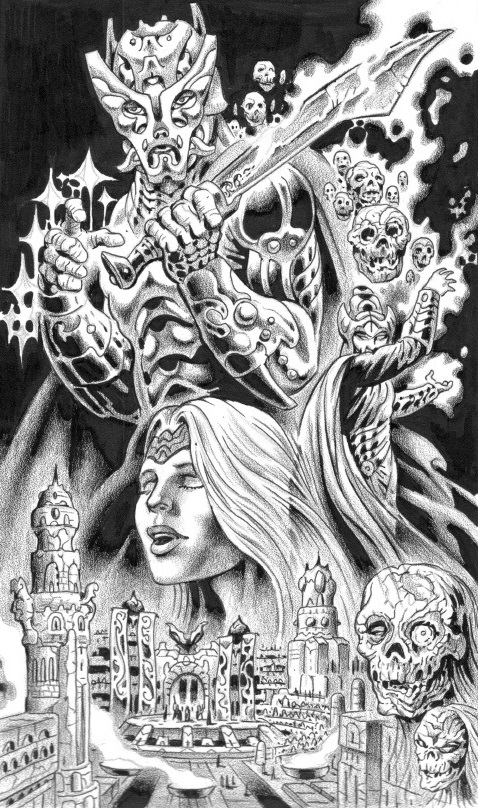
SEL: Let’s discuss the origins of the Zang Cycle. The story “The Persecution of Artifice the Quill” (Weird Tales #340, 2006) opens the Zang Cycle. In our 2017 interview (link), when asked about your ‘Weird Fiction role models’, we learned this story catalyzed your publishing journey. Witnessing the Zang Cycle, and your portfolio, grow is exhilarating. Please share insights about this catalyst.
JRF: “The Persecution of Artifice the Quill,” which begins this book, was my first professional sale. Not only did the story appear in Weird Tales #340, but I’m pretty sure it got the cover illustration. A dark and menacing piece by the great Les Edwards, which seems to capture the look of the undead Vizarchs chasing after Artifice in his debut story. So, it’s a milestone story for me. I had been trying for many years to sell a story to Weird Tales, so mission accomplished.
They bought two more Zang stories before the mag’s management changed, and the next two were not published there after all. Luckily, I moved the Zang series to John O’Neill’s Black Gate, where he published several more stories. About half the stories in The Revelations of Zang were never published outside of its pages — they were new to the volume when it was first released ten years ago. That includes the climactic novella, “Spilling the Blood of the World,” which winds up thematic threads sewn into the first ten stories. I’m forever grateful that I got to be a part of Weird Tales magazine, even if it was only a single story. It opened a gateway to the rest of my career as a writer.
Is ‘Zang proper’ just the forest, or the whole Continent? I initially interpreted it as the latter, but I wanted to be sure.
Zang is one half of a mega-continent, and this half is largely dominated by the ancient Zang Forest (hence the name). The other half, Zin, lies beyond the north/south running mountain range known as the Spine. There may be one or more sleeping gods lying beneath those mountains… but no spoilers. Heh-heh.
Most of the stories in The Revelations of Zang take place in the Zang area of “The Continent” — but when Artifice travels abroad with the Glimmer Faire, they do a nice tour of the Zin regions. Only one story in Revelations takes place in Zin, and that is “The Bountiful Essence of the Empty Hand.” RoZ focuses mainly on what’s happening in Zang, including the mystical advance and expansion of the Zang Forest. [However, there is one more story set in Zin, “Where the White Lotus Grows,” and it appears in the Worlds Beyond Worlds collection.]
To follow that, is “Yael of the Strings” (2014, Shattered Shields; 2021, Worlds Beyond Worlds) a Zang Cycle tale?
Well, it is a tale set in the World of Zang. So is “The Penitence of the Blade” in that same collection. Neither of these Zang tales is related to The Revelations of Zang story-cycle, they simply share the same world or universe. And you could also consider “Where the White Lotus Grows” to be a Zang tale, although it’s set on the other side of the Continent in Zin (as I mentioned above).
The Throne of Bones by Brian McNaughton
(Terminal Fright Publications, 1997). Cover by Jamie Oberschlake
Sticking with digging into origins, let’s hit on the bonus tale: “The Vintages of Dream” (first published in Black Gate #15, 2011). This twelfth story is the only one not explicitly in chronological order or even part of the canonical Zang Cycle; it is a fun piece that reveals how elements of Zang (i.e., carnivorous flowers, thievery of magical potions, etc.) developed. It is dedicated to Brian McNaughton (Throne of Bones, Word Fantasy Award-winning book, 1997) whom you must have corresponded with. Can you explain your interaction with him?
I’m sure I’ve told this story before, but let me just say that Brian was a huge fan of this story. After reading his World Fantasy Award-winning collection The Throne of Bones, I became an instant super-fan. At some point I tried to get “Vintages” published but nobody wanted it. I ended up sending it to Brian, and he even called one mag’s publisher and asked them to buy my story.
It didn’t work, but I was astounded that he spoke up on my behalf. Brian said my writing reminded him of Robert E. Howard, which was a huge compliment for a young writer just getting started. When you’re first starting out, you run on pure enthusiasm, and a kind word from an established writer can really keep you going. Such was the case with Brian’s championing of “Vintages.” It would be many years later when the story finally saw the light of day in Black Gate.
I really wish Brian had lived a few decades longer so he could give us more stories of his wonderfully weird world Seelura. He was a true modern master of the weird tale.
McNaughton’s Throne of Bones sequence is ostensibly ghoul-focused but has omnipresent themes regarding being-an-abject-person and misunderstood-artist (perhaps offering more depressing versions of your Quill who instead leans toward being an action hero). As an artist yourself, creating protagonists who are also artists, please discuss how you see artists as heroes?
Great question. Artists ARE heroes. Like heroes, they have fans. Like heroes, they perform feats of wonder, courage, and bravery. My heroes have always been Artists. (Sorry, Cowboys!) With the Zang stories, I wanted to explore the link between Art and Sorcery. I believe that writing IS magic — I teach writing, and I tell my students the same thing — I believe that all art forms have the capability of altering reality in significant ways that we mostly take for granted. Whether it’s a great novel sweeping you away to another world, a film that transports you somewhere you’ve never been, or simply a painting you could stare at all day, Art is a form of magic.
It’s no coincidence that when you write, you have to “spell” each word out. It’s no coincidence that wizards “sing” their spells because music is a power all on its own. Writing itself may be the Original Magic, so wizards draw runes and sigils to concentrate their power. In the Zang stories, Artifice transitions from an ivory-tower “scribe” to a wandering playwright whose sorcery manifests in the transformational performances of the Glimmer Faire.
I believe in the power of Art to rewrite reality — to make it better — to transcend the mundane, the organic, and the commonplace. To instill wonder, evoke awe, and elevate human existence. Stop me before I get too deep… Heh-heh. I also have to mention that the other “main” protagonist in Revelations is Taizo of Narr, who is not an artist but a smuggler and a thief. At least that’s how he starts… but again, no spoilers.
McNaughton intentionally avoided making a map for his Seelura milieu; there was no map for the Zang Cycle/Continent in its first two printings, but there was for your Books of the Shaper trilogy. Given your artistic skills and creativity, you are likely to have had one. Did you have a map of the Continent? If so, do you have thoughts on sharing maps for fantasy worlds?
Nice of you to point that out! I hadn’t realized it, but I guess I did the same thing that Brian did with Seelura: no map. I have this “mental map” of the World of Zang in my head, but I’ve never drawn it out on paper. With the Books of the Shaper trilogy, the publisher (Orbit) asked me if I wanted to do a map for the novels, so I did a rough and they hired a professional artist to do the final version. It looked great. But I don’t think a map is actually needed for Zang. As Brian said of Seelura, the lack of a map keeps the invented world more mysterious. It’s more like wandering through a dark and shimmering dream without any guideposts or direction. I dig that.
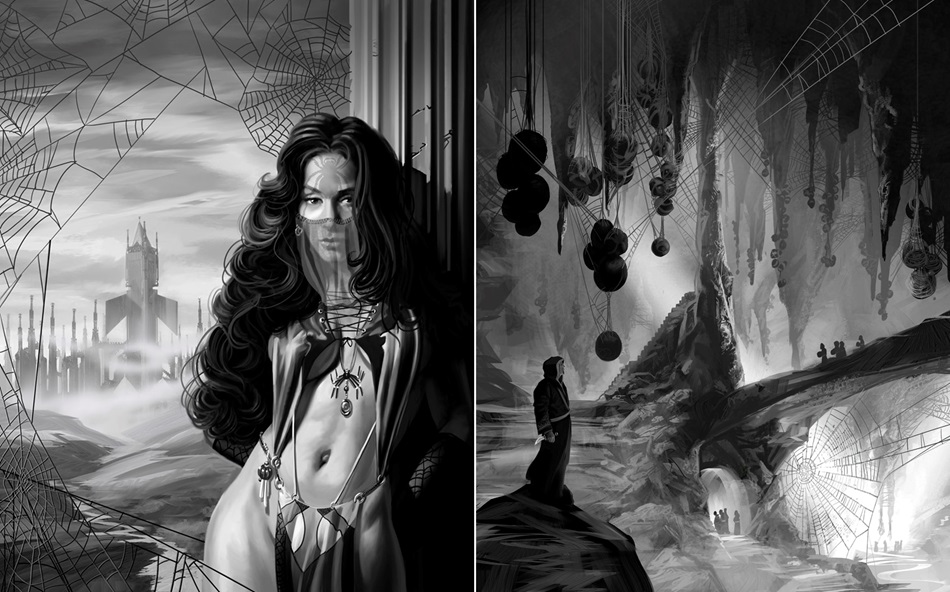
I’m curious about inspirations for the story “When the Glimmer Faire Came to the City of the Lonely Eye” (BlackGate.com 2013, available online) that involves Quill adventuring with a troupe of powerful, weird actors led by the stage master & sorcerer Mordeau; they venture into a haunted city with lofty goals and the reaction from the crowd/world is beyond epic. Loved this story. The last time I remember a troupe in adventure fiction would be the Grillards featured in James Silke’s Frank Frazetta’s Death Dealer novels (Old Brown John being the stage master); note, the Glimmer Faire is magnitudes more powerful and exciting than the Grillards. Anyway, can you discuss your motivations/muses for creating a theatrical group of heroes?
As mentioned previously, I wanted to explore the link between Art and Sorcery. So, when Artifice learns to be a playwright (and simultaneously, a sorcerer), it allowed me to explore how the magical power of Drama can literally change the world.
I’ve always been a big fan of Shakespeare, and I’d have to say one of the influences for The Glimmer Faire was A Midsummer Night’s Dream. The parallels are obvious, what with the Woodfolk musicians being part of the troupe. I wish I could remember more about what inspired the Lonely Eye concept, but I think the title came first, then the plot. I can’t recall anything beyond that, except that I wanted this story to really show how the Faire’s performance could work miracles and wonders — how their High Art transforms an entire community.
But in my ongoing quest to avoid spoilers, I will say no more. Except this: Right around the same time I came up with the Glimmer Faire concept (2003), I saw an excellent historical-drama film called The Reckoning that sort of confirmed and inspired my approach. It stars Willem Dafoe and Paul Bettany as members of a medieval troupe of traveling actors. Fascinating movie. highly recommend it.
In your World Beyond Worlds collection, you have a story dedicated to Kung Fu actor David Carridine, “Where the White Lotus Grows” (Monk Punk, 2011), that harmonizes demon-killing with the ambiance of TV series. In the Zang Cycle, “The Bountiful Essence of the Empty Hand” features a culture seemingly inspired by Kung Fu too. Any connection there? Do you have martial art muses?
Absolutely. I grew up watching Kung Fu in the 70s. Revisited it in the 90s, and eventually collected all three seasons on DVD in the 2000s. Immensely inspiring show, and it introduced my young mind to Eastern philosophy. It’s still one of my all-time favorite TV shows. I do sometimes wonder how different it would have been if Bruce Lee (who co-created the show) had been allowed to play the main role. That went to Carradine instead, but he knocked it out of the park and became one of the biggest TV stars in the world during the 70s.
The tragedy is that David walked away from the show after season three, when its popularity was white-hot, and he would never find that kind of widespread audience again. At least not until 2004, when Quentin Tarantino cast him as “Bill” in KILL BILL. But I also love old-school Shaw Brothers Kung Fu films, and many other directors in the genre.
The Five Deadly Venoms has always been a favorite, and a few years back I discovered the seminal genius of Come Drink With Me. I could go on and on about martial arts cinema, but I prefer the movies that are set deep in the past. They could very well be fantasy films set in alternate worlds, and they inspire me in that way.
In “Bountiful Essence” I got to explore the Zin side of The Continent, and I wanted to explore a culture somewhat akin to the Shaolin monks of ancient China, but not be limited to historical accuracy or concepts. So, the residents of the Invisible City in “Bountiful Essence” are visited by the Glimmer Faire in its tour of the eastern realms. Later, I wanted to explore the fate of Kantoh, one of the monks introduced in “Bountiful Essence,” so I returned to Zin and wrote “Where the White Lotus Grows.” It only seemed right to dedicate the story to David Carradine, since he inspired me at such an early age with his portrayal of Kwai Chang Caine.
I love the martial arts films of Zhang Yimou, Ang Lee, and Yang Lu. I also find the show Warrior to be fantastically good and totally inspiring. It’s almost like an answer to my above question since it’s produced by Bruce Lee’s daughter and based on his writings. I can confidently say it’s the best martial arts show since the original Kung Fu, and it’s set in the same time period. Great stuff.
There seem to be crossovers or tie-ins, such as the Ghothian spiders (that have a dominant focus in “Oblivion Is the Sweetest Wine (Black Gate #12, 2008), but also appear in World Beyond Worlds – ‘Yael of the Strings” (originally published in Shattered Shields (2014)). Less explicitly, the nine Sorcerer Kings and Divine Council of the Zang Cycle seems to resonate with the Seven Sorcerer Kings from the Books of the Shaper trilogy. Does the Zang Cycle spill over to other Fultz Universes?
No, no — very different concepts, and very different stories. The kings in the novel Seven Kings are not all sorcerers. In fact, only a couple of them are sorcerers if I recall correctly; they are the kings of various nations allied and/or divided by a coming war. That book is a completely different universe, totally unrelated to Zang in any way — except that I wrote both of them.
In The Revelations of Zang, there are nine Sorcerer Kings who rule a single city (Narr the Golden) and its surrounding empire. They are “the enemy” of our protagonists because long ago they cast down the Gods of Zang and all their temples, replacing the worship of gods with the worship of themselves. They even refer to themselves as the Divine Council. So, a part of the journey in RoZ is the idea that you can’t really kill the gods, so what if they decide to come back? That’s the kind of thing we call an apocalypse…
Your Moroquin creatures remind me of fleshy versions of the Garthim (Jim Henson and Frank Oz’s 1982 Dark Crystal movie) which are giant clawed, exoskeletal elite guards/warriors serving the antagonists. Did the Garthim inspire the Moroquin?
No, but I do enjoy the original Dark Crystal film. At the time there was nothing else like it. I just wanted the Moroquin to be absolutely disgusting brutes — the tools of blind fascism and decadent sorcery. Grotesque and demonic.
You are an accomplished illustrator. Early in your storytelling career you wrote Primordia for Archaia Studios Press and wrote/illustrated the graphic novel Necromancy/SKULLS, available on Black Gate.com (table of contents here: link). Have you ever drawn Moroquin, Vizarchs, or anything else for the Zang Cycle? Please discuss how drawing informs your writing now. If you have illustrations, can we share?
Well, thanks for the kind words, but actually I’m an amateur illustrator. I don’t have the skill to do professional illustration, but I’ve always loved to draw. So, I indulge that fancy sometimes. In the case of Primordia, I got the great Roel Wielinga to draw it and he did an amazing job. In the case of Skulls, that was back when I was trying to break into the comics industry and got tired of artists bailing out on pitches and projects.
So, I started drawing and inking myself. I learned a lot from doing that, and I think my inking worked better than my pencils. Later, I re-envisioned that story as a web comic and repurposed it to run at Black Gate. I don’t really draw comics anymore. I’d love to write them, however, if the opportunity arises.
Any other behind-the-scenes context you’d like to share about the Zang Cycle?
Just that I’m so grateful that the Rogues in the House Podcast crew have decided to publish this second edition of Revelations of Zang. It’s been out of print for several years, so it will be great to make it available again for new readers. The Rogues also found a terrific artist, John Molinero, to paint a brand-new cover for the new edition. It rocks!
We hope that this collection can be an entry into published Fultz works, or perhaps future ones. On social media, there was a tease about two new novels called the Scaleborn series. Can you discuss future Fultz endeavors?
All I can say at this point is that the Scaleborn series is looking for a home, and I’ve got the first two books already completed. I’m hoping it will find a publisher before too much longer.
#Weird Beauty Interviews on Black Gate
- Darrel Schweitzer THE BEAUTY IN HORROR AND SADNESS: AN INTERVIEW WITH DARRELL SCHWEITZER 2018
- Sebastian Jones THE BEAUTY IN LIFE AND DEATH: AN INTERVIEW WITH SEBASTIAN JONES 2018
- Charles Gramlich THE BEAUTIFUL AND THE REPELLENT: AN INTERVIEW WITH CHARLES A. GRAMLICH 2019
- Anna Smith Spark DISGUST AND DESIRE: AN INTERVIEW WITH ANNA SMITH SPARK 2019
- Carol Berg ACCESSIBLE DARK FANTASY: AN INTERVIEW WITH CAROL BERG 2019
- Byron Leavitt GOD, DARKNESS, & WONDER: AN INTERVIEW WITH BYRON LEAVITT 2021
- Philip Emery THE AESTHETICS OF SWORD & SORCERY: AN INTERVIEW WITH PHILIP EMERY 2021
- C. Dean Andersson DEAN ANDERSSON TRIBUTE INTERVIEW AND TOUR GUIDE OF HEL: BLOODSONG AND FREEDOM! (2021 repost of 2014)
- Jason Ray Carney SUBLIME, CRUEL BEAUTY: AN INTERVIEW WITH JASON RAY CARNEY (2021)
- Stephen Leigh IMMORTAL MUSE BY STEPHEN LEIGH: REVIEW, INTERVIEW, AND PRELUDE TO A SECRET CHAPTER (2021)
- John C. Hocking BEAUTIFUL PLAGUES: AN INTERVIEW WITH JOHN C. HOCKING (2022)
- Matt Stern BEAUTIFUL AND REPULSIVE BUTTERFLIES: AN INTERVIEW WITH M. STERN (2022)
- Joe Bonadonna MAKING WEIRD FICTION FUN: GRILLING DORGO THE DOWSER! (2022)
- C.S. Friedman. BEAUTY AND NIGHTMARES ON ALIENS WORLDS: INTERVIEWING C. S. FRIEDMAN (2023)
- John R Fultz BEAUTIFUL DARK WORLDS: AN INTERVIEW WITH JOHN R. FULTZ (2023 report of 2017 interview)
- John R Fultz “The Magical Power of Art” – Foreword and Interview for The Revelations of Zang (2024 Interview)
- interviews prior 2018 (i.e., with Janet E. Morris, Richard Lee Byers, Aliya Whitely …and many more) are on S.E. Lindberg’s website
S.E. Lindberg is a Managing Editor at Black Gate, regularly reviewing books and interviewing authors on the topic of “Beauty & Art in Weird-Fantasy Fiction.” He is also the lead moderator of the Goodreads Sword & Sorcery Group and an intern for Tales from the Magician’s Skull magazine. As for crafting stories, he has contributed six entries across Perseid Press’s Heroes in Hell and Heroika series, has an entry in Weirdbook Annual #3: Zombies He independently publishes novels under the banner Dyscrasia Fiction; short stories of Dyscrasia Fiction have appeared in Whetstone, Swords & Sorcery online magazine, Rogues In the House Podcast’s A Book of Blades Vol I and Vol II, DMR’s Terra Incognita, and the 9th issue of Tales From the Magician’s Skull. For several years he has played leading organizational roles for the Gen Con Writers’ Symposium.
